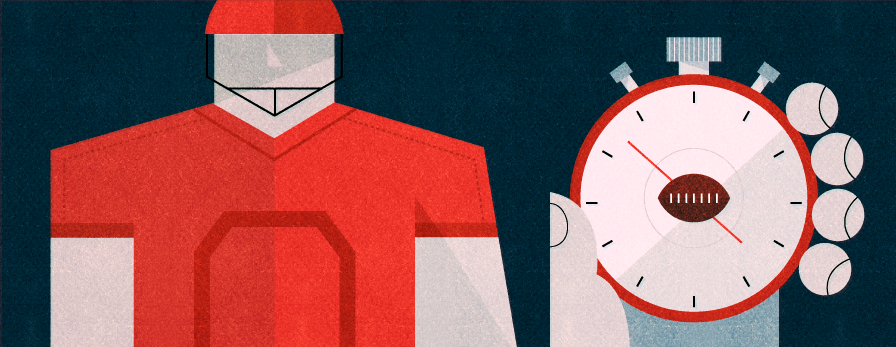Key Findings
- No team at least as far back as 2002 has finished the season (bowl game included) without a clutch drive.
- FSU has not had a clutch drive yet this season.
- Duke has had the most clutch drives – 24 spread across 8 games.
Not every minute in the course of a college football season is particularly meaningful. For example, consider the fourth quarter of the matchup between Florida State (FSU) and Bethune-Cookman earlier this season. FSU entered the quarter up 54-6. We can be fairly certain that FSU was not pulling out all the stops to pile on the points down the stretch. For some teams, a significant percentage of games contain this sort of junk time. Yet, we still analyze and judge teams based on cumulative or average production over a whole season.
The final minutes of these runaway games represent the low end of the meaningful spectrum. There is also the other extreme, those times when coaches call their best plays, defenses up the intensity, and a single pass or interception can decide the game. In this article we analyze the most important minutes, what we consider clutch time in a college football game.
Summary Clutch Statistics for the BCS Top 25
For the top 25 teams in the BCS, we looked at all drives that met the following three conditions.
- The drive ended in the fourth quarter or overtime.
- The difference in score between the two teams was less than or equal to eight at the start of the drive.
- The drive was not simply a sequence of kneels without a first down.
The number of these drives in each game for a team can often be more telling than the difference in the final score. For example, Duke lost to Pittsburgh by three points on September 21. However, Duke never had a clutch drive in that game. They never had the ball with the chance to take the lead or tie the game. Pittsburgh was in more control than the final score implies. The same occurred when Texas A&M lost by seven to Alabama on September 14th. For comparison, consider Alabama’s loss to Auburn on November 30th. Alabama lost by six, but had 5 clutch drives. The last of which ended in a now famously short field goal attempt that would have won the game.
Tables 1 and 2 present summary statistics for clutch time. Teams are listed in order of their BCS rank. Table 1 includes the number of games in which the team had a qualifying clutch drive (G), the total number of drives, and then the results of those drives. EoQ is the number of drives that ended because time ran out. We then show the number of drives that ended in a touchdown (TD) or field goal (FG), and the corresponding percentages (TD% and FG%). Scor% is the total percentage of drives that ended in a touchdown or field goal.
Table 1: BCS Top 25 Clutch Statistics: Scoring Drives
| Team | G | Drives | EoQ | TD | TD% | FG | FG% | Scor% |
| Florida St. | 0 | 0 | 0 | 0 | – | 0 | – | – |
| Ohio St. | 4 | 9 | 0 | 4 | 44 | 1 | 11 | 56 |
| Auburn | 6 | 17 | 1 | 5 | 29 | 2 | 12 | 41 |
| Alabama | 3 | 7 | 0 | 3 | 43 | 0 | 0 | 43 |
| Missouri | 6 | 15 | 1 | 7 | 47 | 1 | 7 | 53 |
| Oklahoma St. | 3 | 8 | 0 | 2 | 25 | 1 | 13 | 38 |
| Stanford | 6 | 16 | 2 | 2 | 13 | 1 | 6 | 19 |
| South Carolina | 6 | 16 | 2 | 5 | 31 | 3 | 19 | 50 |
| Baylor | 2 | 8 | 0 | 2 | 25 | 0 | 0 | 25 |
| Michigan St. | 5 | 9 | 0 | 3 | 33 | 2 | 22 | 56 |
| Arizona St. | 4 | 12 | 0 | 4 | 33 | 0 | 0 | 33 |
| Oregon | 3 | 6 | 0 | 4 | 67 | 0 | 0 | 67 |
| Clemson | 4 | 5 | 0 | 3 | 60 | 0 | 0 | 60 |
| Northern Illinois | 8 | 20 | 1 | 8 | 40 | 3 | 15 | 55 |
| LSU | 6 | 11 | 0 | 6 | 55 | 2 | 18 | 73 |
| UCF | 6 | 16 | 1 | 6 | 38 | 3 | 19 | 56 |
| Oklahoma | 6 | 11 | 1 | 5 | 45 | 2 | 18 | 64 |
| UCLA | 5 | 13 | 0 | 2 | 15 | 1 | 8 | 23 |
| Louisville | 4 | 10 | 1 | 2 | 20 | 0 | 0 | 20 |
| Duke | 8 | 24 | 2 | 7 | 29 | 2 | 8 | 38 |
| Wisconsin | 4 | 8 | 1 | 2 | 25 | 1 | 13 | 38 |
| Georgia | 9 | 23 | 3 | 8 | 35 | 3 | 13 | 48 |
| Fresno St. | 5 | 15 | 0 | 6 | 40 | 2 | 13 | 53 |
| Texas A&M | 4 | 15 | 0 | 5 | 33 | 3 | 20 | 53 |
| Texas | 2 | 9 | 0 | 3 | 33 | 1 | 11 | 44 |
| Total (Or avg %) | 119 | 303 | 16 | 104 | 34 | 34 | 11 | 46 |
Table 2 contains the not so favorable outcomes. These include missed field goals (FGMi), interceptions (Int), fumbles lost (Fumb), turnover on downs (TOD), and punts. TO% is the percentage of drives that ended in an interception, fumble or turnover on downs. Punt% is the percentage of drives that ended in a punt.
Table 2: BCS Top 25 Clutch Statistics: Nonscoring Drives
| Team | FGMi | Int | Fumb | TOD | TO% | Punts | Punt% |
| Florida St. | 0 | 0 | 0 | 0 | – | 0 | – |
| Ohio St. | 0 | 0 | 1 | 0 | 11 | 3 | 33 |
| Auburn | 0 | 1 | 2 | 1 | 24 | 5 | 29 |
| Alabama | 3 | 0 | 0 | 1 | 14 | 0 | 0 |
| Missouri | 1 | 0 | 0 | 0 | 0 | 5 | 33 |
| Oklahoma St. | 1 | 1 | 0 | 0 | 13 | 3 | 38 |
| Stanford | 1 | 3 | 0 | 1 | 25 | 6 | 38 |
| South Carolina | 0 | 0 | 0 | 1 | 6 | 5 | 31 |
| Baylor | 1 | 0 | 0 | 0 | 0 | 5 | 63 |
| Michigan St. | 0 | 0 | 0 | 1 | 11 | 3 | 33 |
| Arizona St. | 0 | 2 | 0 | 0 | 17 | 6 | 50 |
| Oregon | 1 | 0 | 0 | 0 | 0 | 1 | 17 |
| Clemson | 0 | 0 | 1 | 0 | 20 | 1 | 20 |
| Northern Illinois | 1 | 0 | 1 | 0 | 5 | 6 | 30 |
| LSU | 0 | 0 | 0 | 2 | 18 | 1 | 9 |
| UCF | 0 | 1 | 0 | 0 | 6 | 5 | 31 |
| Oklahoma | 0 | 0 | 0 | 0 | 0 | 3 | 27 |
| UCLA | 1 | 3 | 0 | 1 | 31 | 5 | 38 |
| Louisville | 1 | 0 | 1 | 1 | 20 | 4 | 40 |
| Duke | 1 | 1 | 0 | 0 | 4 | 11 | 46 |
| Wisconsin | 0 | 1 | 0 | 1 | 25 | 2 | 25 |
| Georgia | 0 | 2 | 2 | 1 | 22 | 4 | 17 |
| Fresno St. | 0 | 0 | 2 | 0 | 13 | 5 | 33 |
| Texas A&M | 0 | 0 | 1 | 1 | 13 | 5 | 53 |
| Texas | 0 | 0 | 2 | 0 | 22 | 3 | 33 |
| Total (Or avg %) | 12 | 15 | 13 | 12 | 13 | 97 | 32 |
We begin our analysis at the top. Florida State features an incredibly talented freshman quarterback Jameis Winston. As an inexperienced freshman, we might wonder how good Winston can be in the highest-pressure situations, when the game is on the line, and he has one drive to seal the victory. After our analysis, we are still left wondering. FSU has not a clutch drive yet. This is tremendous evidence of their dominance. Teams can avoid clutch drives in two ways: winning easily and losing easily.
As an undefeated team, FSU avoided clutch moments for the best reasons, and may be in unprecedented territory. No undefeated team at least as far back as 2002 has finished the season (bowl game included) without a clutch drive. One team came close. In 2004, Utah had 1 clutch drive. It came against Air Force and ended at the 12:44 mark in the 4th quarter. Utah scored a touchdown on that drive to go up 14, and held at least a 14-point lead for the remainder of the game.
Note that Alabama had only 2 total clutch drives in their 11 wins demonstrating how dominant the team had been prior to the Auburn loss.
FSU has had 0 clutch drives. One of the BCS’s other undefeated teams, Northern Illinois, has had 20 drives spread across 8 games, in spite of playing what many would argue has been a far weaker schedule than FSU has encountered.
The honor of having the most clutch drives belongs to FSU’s ACC Championship Game opponent, Duke. Duke had 24 clutch drives spread across 8 games.
For most teams, clutch time is inevitable. We now consider how these teams faired in these situations. In doing so, we have to keep in mind that clutch time is a small (albeit important) sample set.
Last season, UCLA’s featured a promising freshman quarterback Brett Hundley. He threw for 3,745 yards and had a QBR (ESPN Quarterback rating) of 61.2. Thus far in his sophomore season, Hundley has thrown for 2,845 yards. A number of his other statistics have improved. His completion percentage, yards per attempt, and QBR are up. He has thrown only 9 interceptions, as compared to 11 a season ago. However, relative to the rest of the top teams, UCLA has not performed well in the clutch. UCLA has only scored on 23% of these drives (compared to the BCS top 25 average of 46%). Also, they have had 3 interceptions, and 4 total turnovers in just 13 clutch drives. This is a turnover percentage of 31, the highest among the top 25 teams.
We went back to look at UCLA’s 2012 clutch performance. That season, they scored on 27% of their 15 drives, which is slightly better than the 2013 rates. The biggest difference was the turnover rate. In 2012, UCLA did not turn the ball over once in clutch drives.
Table 3:2012 UCLA Clutch Statistics
| Team | G | Drives | EoQ | TD | TD% | FG | FG% | Scor% |
| UCLA | 6 | 15 | 2 | 3 | 20 | 1 | 7 | 27 |
| Team | FGMi | Int | Fumb | TOD | TO% | Punts | Punt% | |
| UCLA | 2 | 0 | 0 | 0 | 0 | 7 | 47 |
One of the better clutch teams has been Oklahoma; they have scored on 64% of their 11 clutch drives. They have also not turned the ball over in these situations.
Conclusions
Clutch performance matters. Ask the Georgia team that had a punt and two fumbles in their three clutch drives against Vanderbilt on October 19th. This allowed Vanderbilt to score 17 unanswered points in the fourth quarter, overcome a 14-point deficit, and upset the higher seeded Bulldogs.
These simple methods of measuring clutch performance may enhance our understanding of the caliber of teams and why these teams are successful.
Win AD equips your athletic department with the resources to pull off a clutch performance with easy benchmarking—customizable comparisons of revenue and expense trends between institutions. Get a 5-year view of NCAA financials in the same place you compare wins/losses, post-season performance, APR, and RPI for every sport—from football to fencing. Win AD is a better way to manage resources and maximize performance.
Contact us for a tour of Win AD




